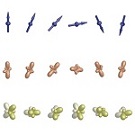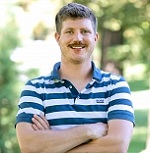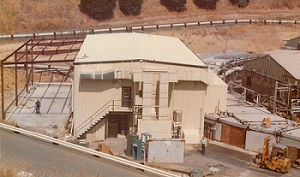Vol. 20, No. 1 - July 2019
View the Archives

Science Highlight Unveiling the Orbital Density Waves in MnP – Contact: Jun-Sik Lee (SSRL) The field of superconductivity was surprised by the discovery of a manganese-based superconductor, published in 2015. Because the electrons in manganese do not form couplets called Cooper pairs, it was not thought possible that manganese could have traits of superconductivity. This discovery necessitates a revised explanation for superconductivity, one not requiring Cooper pairing. The unconventional pairing of electrons in the manganese superconductor MnP provides a novel system to understand the phenomenon of superconductivity. Read more... AwardsHans-Georg Steinrück Receives 2019 Spicer Award Excerpt from July 26, 2019 SLAC News Article by Bobbi Fagone
Hans-Georg Steinrück, a versatile scientist who has made important contributions to research involving lithium-ion batteries, organic transistors, and catalysis, has been chosen to receive the 2019 William E. and Diane M. Spicer Young Investigator Award. This award is given each year to early-career scientists who perform research at SSRL. The Spicer award will be presented to Steinrück during the 2019 SSRL/LCLS Annual Users’ Meeting and Workshops on September 26. For the past four years, Steinrück has undertaken several challenging projects using x-rays to investigate fundamental aspects of battery operation. His results have had significant implications for lithium-ion batteries, in particular concerning how ions are transported into the battery electrode. This can determine the rate at which a battery can be charged and discharged. Despite being new to the field of energy storage when he started at SLAC, Steinrück has since made a significant impact on SSRL’s footprint in this field with several publications in high impact journals, such as Nano Letters, Energy and Environmental Science and Joule. Read more... Beam Line DevelopmentChanges Planned for SSRL Materials Science X-ray Scattering Beam Lines There are exciting things happening for the SSRL x-ray scattering beam lines. We are in the process of building a new undulator beam line, BL17-2, to provide world-class scattering capabilities for energy sciences. With this new facility, the BL7-2 science program will move to BL17-2 once the new station is ready. We are looking forward to opportunities to share information on the capabilities of this new beam line and discuss the new science that this will enable for our users. There will be a workshop at the upcoming SSRL Users’ Meeting for just that purpose. As a consequence of this change, we will be unable to schedule BL7-2 beyond the second cycle of the FY2020 experimental run. With the next round of beam time requests due on August 1, please be sure to request whatever time may be needed to finish projects on BL7-2. We will be moving the diffractometer from BL7-2 into the new BL17-2 hutch at the end of the second scheduling cycle (May 2020) for commissioning of the beam line and expect to begin scheduling users at the start of the FY2021 experimental run. Please contact SSRL staff Apurva Mehta, Kevin Stone or Chris Tassone for more information. Deadlines for Lytle Award and Users’ Executive Committee NominationsSubmit Nominations for the Lytle Award by August 5 The $1,000 Lytle Award was established to promote technical or scientific accomplishments in synchrotron radiation-based science and to foster collaboration and efficient use of beam time at SSRL. The award will be presented during our Annual Users' Meeting. SSRL users and staff are eligible to be nominated for the Lytle Award. Letters of nominations should include a summary of the individual's contributions and why they should be recognized through this award. Supporting letters are welcome. Send nominations to Cathy Knotts. Submit Nominations for the SSRL Users’ Executive Committee by September 5 We welcome candidates interested in standing for election to the SSRL Users Executive Committee (UEC). The UEC provides an organized framework for interaction between the SSRL scientific user community and SSRL Management. We are currently seeking nominations from the Environmental/Geosciences and Macromolecular Crystallography communities. UEC elections are held annually in conjunction with the Users' Meeting. The SSRL UEC generally meets quarterly to plan the Users' Meeting in coordination with the LCLS UEC, select recipients for several awards, provide input to SSRL management on topics of interest to the user community, and to raise awareness about SSRL capabilities, user science and accomplishments to a broader audience. Nomination form MilestonesSSRL Celebrates 46th Anniversary
Do you recall what you were doing in July 1973? Well, a few forward thinking scientists were participating in an experiment to capture the first beams of x-ray light (synchrotron radiation) produced by the Stanford Positron Electron Accelerating Ring (SPEAR). Click to learn more about the history of SPEAR and SSRL, including the 1972 decision to start a pilot project in cooperation with the Stanford Center for Materials Research and subsequent funding from the National Science Foundation, the U.S. Navy, Xerox Corp. and Bell Telephone Laboratories to establish the Stanford Synchrotron Radiation Project (SSRP) which was later became the Stanford Synchrotron Radiation Laboratory (SSRL). EventsFalling Walls Competition, September 24, 2019 SLAC, Stanford and X the Moonshot Factory announce the 2019 Falling Walls Lab Stanford to be held at SLAC’s Kavli Auditorium on September 24, 3-5 pm. At this fun competition and networking event, you can pitch your great new idea or watch the competitors pitch theirs. Anyone within 10 years of Bachelors, 7 years of Masters or 5 years of PhD is eligible to compete. The winner will receive a trip to the final on November 9 in Berlin. To learn more or apply, visit the Falling Walls website. Joint SSRL/LCLS Users’ Meeting, September 24-27, 2019 We encourage you to participate in our Annual Users' Meeting. The User’s Meeting will include facility updates, a DOE BES update, invited talks from Stosh Kozimor (LANL) and Philippe Wernet (Helmholtz-Zentrum Berlin), a user poster session (with prizes for outstanding posters) and several focused workshops:
September 18 is the deadline to register for the meeting and also to submit an abstract for the poster session. EMSL Integration 2019 – Plants, Soil and Aerosols: Interactions that Tell Stories of Ecosystems, Climate and National Security, October 8-10, 2019 announcement U.S. Particle Accelerator School, UC San Diego, January 13–24, 2020 The next program of particle accelerator courses will be sponsored by and held at the University of California San Diego, January 13–24, 2020. Interested participants may enroll for 2 or 4 quarter units of academic credit from UC San Diego Extension or may audit their course. Visit the website for course descriptions and to submit an application. Limited financial support may be available, including new travel scholarship opportunities offered by the Division of Physics of Beams (DPB) of the American Physical Society. More details on eligibility and selection criteria are available at DPB Scholarship Details. User Research AdministrationBeam Time Requests
Proposal Deadlines
Submit beam time requests and proposals through the User Portal. _____________________________________________________________________ The Stanford Synchrotron Radiation Lightsource (SSRL) is a third-generation light source producing extremely bright x-rays for basic and applied research. SSRL attracts and supports scientists from around the world who use its state-of-the-art capabilities to make discoveries that benefit society. SSRL, a U.S. DOE Office of Science national user facility, is a Directorate of SLAC National Accelerator Laboratory, operated by Stanford University for the U.S. Department of Energy Office of Science. The SSRL Structural Molecular Biology Program is supported by the DOE Office of Biological and Environmental Research, and by the National Institutes of Health, National Institute of General Medical Sciences. For more information about SSRL science, operations and schedules, visit http://www-ssrl.slac.stanford.edu. To unsubscribe from SSRL Headlines, just send an e-mail to listserv@slac.stanford.edu with "signoff ssrl-headlines" in the body. To subscribe, send an e-mail to listserv@slac.stanford.edu with "subscribe ssrl-headlines" in the body. Questions? Comments? Contact Lisa Dunn
|


